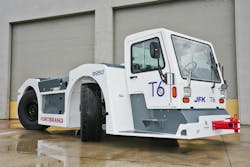JFK Terminal 6 to Debut First Pooled Electric GSE Fleet in North America
The Port Authority of New York and New Jersey (PANYNJ) and JFK Millennium Partners (JMP) have announced a groundbreaking agreement that will make John F. Kennedy International Airport’s upcoming Terminal 6 the first in North America to operate a pooled fleet of fully electric ground support equipment (GSE).
The project, set to debut with the first phased opening of T6 in 2026, is expected to transform ramp operations while significantly cutting emissions.
Under the agreement, Long Island–based Fortbrand Services will manage and operate the fleet, supplying, maintaining, and tracking all GSE in a common-use model shared among airlines. The approach is designed to eliminate duplication, ease apron congestion, and improve safety, all while advancing the Port Authority’s roadmap to net-zero emissions by 2050.
“The Port Authority’s nation-leading commitment to achieve net-zero emissions by 2050 includes a transition to the use of all commercially available zero emission ground support equipment at the region’s airports,” said Port Authority Executive Director Rick Cotton. “The agreement between JFK Millennium Partners and Fortbrand to serve Terminal 6 with shared electric ground support equipment represents an exciting step toward reaching our goal.”
Jared Verano, CEO of Fortbrand, added, “Fortbrand was founded over 40 years ago to support New York’s airports, so we are excited to partner with JMP to provide JFK T6 with essential equipment, maintenance, and fleet management services for this innovative operation.”
“This initiative is a game changer,” said Steve Thody, CEO of JFK Millennium Partners. “At JFK Terminal 6, we’ve had the opportunity to start fresh and reimagine how operations on the ramp should look. Pooling ground service equipment and making it fully electric brings together safety, efficiency, and sustainability in a way that hasn’t been done before in the U.S.”
Cutting emissions and streamlining the ramp
According to PANYNJ, the T6 electric fleet will cut approximately 2,500 metric tons of carbon dioxide annually - the equivalent of driving a gasoline-powered car six million miles. Each of the terminal’s 10 gates will be equipped with its own dedicated set of electric GSE, eliminating the need for airlines or handlers to move equipment across the ramp.
“This concept has been around for a while, but it was always tricky to execute,” Thody explained. “When you have multiple handlers with their own fleets, you get congestion, inefficiencies, and the potential for increased safety risks. By pooling equipment and leveraging today’s technology, we can track usage, ensure only trained operators are using it, and keep the ramp organized and safe.”
The common-use model is also expected to reduce airline costs. While the upfront expense of electric equipment is higher, Thody said the efficiencies of pooling create substantial savings. ”The efficiency gains are in the 25 to 30 percent range. That’s a massive improvement for airlines,” he said.
Technology and telematics at the core
One of the key enablers of the project is the integration of advanced telematics and safety systems. Fortbrand’s fleet management software will monitor equipment location, battery life, driver authorization, and performance in real time. Safety features such as speed controls, automatic slowing near aircraft, and dual-camera monitoring are being built into the new units.
“Technology has really been the needle we’ve threaded to make this program work,” Thody said. “Telematics means we know who’s using the equipment, how it’s being used, and if it’s being used responsibly. That not only improves accountability, it helps us give ground handlers feedback and best practices to run more efficient operations.”
Training programs are being developed to familiarize handlers with electric operations and the terminal’s broader energy efficiency goals. “Transitioning from diesel to electric requires a culture change,” Thody noted. “We’re building training and retraining into the rollout to make sure the culture of care around the fleet is there from day one.”
Collaboration from the start
JMP emphasized that the pooling project was developed collaboratively with airlines that will operate at T6. According to Thody, carriers were involved from the beginning of the request-for-proposal process, helping to define equipment standards, specifications, and operational requirements.
“This wasn’t something we just decided and handed down,” Thody said. “We engaged our airline partners from day one. They were at the table through the RFP, through the standards, and through the selection of Fortbrand. That collaboration has been critical in building trust and ensuring everyone is behind the model.”
The separation of equipment from manpower was another shift. Traditionally, airlines select ground handlers who supply both labor and equipment. Under the new system, handlers will provide staff while the common-use fleet is maintained centrally by Fortbrand and JMP.
“By standardizing equipment and separating it from manpower, we give airlines more flexibility in choosing handlers while ensuring everyone has access to safe, modern equipment,” Thody explained.
All eyes on JFK, and beyond
The move is drawing attention across the industry. While pooled GSE fleets have been used in Europe, JFK T6 will be the first North American terminal to adopt the model at scale.
“Our peers are watching closely,” Thody acknowledged. “We expect a lot of questions once this announcement is out: How did you do it? What challenges did you face? How do you assign responsibility for damage? People are curious because pooling has always had hurdles. Our job now is to prove the model works.”
The data generated from telematics is expected to yield new insights into aircraft turnaround times, ramp efficiency, and handler performance. “We’re opening up a world of information we haven’t had before,” said Thody. “That’s going to help us manage the ramp more effectively and provide airlines with data that supports punctuality and better customer service.”
Building toward 2030
The electric fleet is part of a broader sustainability strategy for Terminal 6. The building is targeting LEED and ENVISION Gold certifications, with additional features such as high-efficiency systems, water reuse, and the installation of more than 4,000 solar panels.
While the T6 fleet will be primarily electric from day one, the goal is to be 100 percent electric by 2030. “We’ve contracted with the Port Authority to meet full electrification no later than 2030,” Thody said. “In reality, we expect to get there by 2028, when the terminal is fully complete. It depends on the market availability of certain larger equipment, but the trajectory is clear.”
Thody added that the environmental benefits are inseparable from operational gains. “This isn’t just about sustainability for its own sake,” he said. “Cleaner, safer, more efficient equipment means fewer delays, fewer incidents, and a smoother operation overall.”
A model for the future
The Terminal 6 announcement comes amid a $19-billion redevelopment of JFK, which includes the $9.5-billion New Terminal One, the $4.2-billion T6, and other major upgrades. Both T6 and the New Terminal One are set to open with common-use electric GSE fleets, signaling a wider transformation in how ramp operations are managed.
“At JFK T6, gone are the days of unnecessary duplication of ground handling equipment - which translates into additional CO2 emissions and inefficient aircraft operations,” said Karen Ali, Chief Operating Officer, JFK Millennium Partners. “Our future all-electric T6 ground fleet, monitored and maintained together with Fortbrand and our partners, will be a game changer for our airlines and underlines our company’s commitment to sustainable operating practices throughout our terminal.”
For Thody, the program represents both a milestone for JFK and a potential blueprint for other airports. “We believe Terminal 6 will demonstrate that this model is not only sustainable but economically sound and operationally superior,” he said. “Getting this right, could change the way ground support equipment is managed across the U.S.”
With construction of Terminal 6 well underway and its first gates scheduled to open in 2026, aviation ground support professionals across the country will be watching closely.
“The eyes of the industry are on us,” Thody said. “Our responsibility is to show that pooling electric GSE works, that it’s safer, more efficient, and more sustainable. And we’re confident it will be.”


